AUDI S8 2014 Owners Manual
Manufacturer: AUDI, Model Year: 2014, Model line: S8, Model: AUDI S8 2014Pages: 314, PDF Size: 78.47 MB
Page 151 of 314

To provide maximum protection, safety belts
must always be positio ned correctly on the
wearer's body .
... Adjus t the front seat and head restraint
properly
c::> page 58, General recommenda
tions .
... Hold the be lt by the tongue and pull it even
ly across the chest and pelvis
c::> &,. .
... Insert the tongue into the correct buckle of
you r seat until you hear it latch securely
c::> fig. 161.
... Pull on the belt to make su re that it is se-
c u rely latched in the buckle .
Automatic safety belt retractor s
Every safety belt is equipped with an automat
ic belt retractor on the shoulder belt. Th is fea
ture locks the belt when the belt is pulled out
fast, dur ing hard braking and in an accident .
The belt may also lo ck when you drive up or
down a steep hill or through a sharp curve .
D uring normal driving the belt le ts you move
freely.
Safety belt pretensione rs
The safety belts are equipped with a belt pre
tensioner that helps to t igh ten the safety belt
and remove s lack when the pretensione r is ac
tivated
c::> page 151. The function of the pre
tensioner is monitored by a warning light
c::> page 18 .
Switchable locking feature
E very safety belt except the one on the driver
seat is eq uipped w ith a switchab le locking fea
ture that
mu st be used when the safety belt is
used to attach a child seat. Be sure to read the important information about this feature
c:;,page 187.
A WARNING
Improperly positioned safety belts can
cause serious injury in an accident
c::> page 149, Safety belt position .
-Safety belts offer optimum protection
only when the seatback is up right and
belts are properly positioned on the
body.
-
Safety belts 149
- Never attach the safety belt to the buck
le for another seat. Attaching the belt to
the wrong buckle will reduce safety belt effectiveness and can cause serious per
sonal injury .
- A passenger who is not properly restrain
ed can be seriously injured by the safety
be lt itself when it moves from the stron
ge r parts of the body into critical ar eas
like the abdomen.
- Always lock the convertible locking re
tracto r when you a re secu ring a child
se at in the veh icle
c::>page 189.
@ Tips
For informat ion on safety belt pretension
e rs, refer to
c::> page 151 .
Safety belt position
Correct belt position is the key to getting
maximum protection from safety belts .
Fig. 1 62 Safety belt pos it ion
Use the heig ht adjus tment to change the posi
tion o f the shoulder belt of the front safety
belts.
A WARNING '-
Improperly positioned safety be lts can
cause ser ious persona l injury in an acc i
dent.
-
- The shou lder belt should lie as close to
the center of the collar bone as possible
and should fit well on the body. Hold the
be lt above the latch tongue and pull it
eve nly across the chest so that it sits as
low as possible on the pelv is and there is
no pressure on the ab domen. The belt .,_
Page 152 of 314

150 S afet y belt s
should a lways fit snugly ¢ fig. 162. Pull
on the belt to tighten if necessary.
- A loose-fitting safety be lt can cause seri
ous injuries by shifting its position on
your body from the strong bones to more
vulnerab le , soft tissue and cause serious
injury .
- Always read and heed all WARNINGS and
other important informat ion
¢ page 148.
Pregnant women must also be correctly
restrained
The best way to protect the fetus is to make
sure that expectant mothers always wear
safety belts correctly -throughout the preg
nancy.
Fig . 163 Safety belt posit ion duri ng pregnancy
To provide maximum protection, safety belts
must always be positioned correctly on the
wearer's body¢
page 149.
• Adjust the front seat and head restra int cor
rect ly ¢
page 58, General recommenda
tions.
• Hold the belt by the tongue and pull it even
ly across the chest and pelvis
¢ fig. 163,
¢Li). .
• Insert the tongue into the correct buckle of
your seat until you hea r it latch securely
¢page 148, fig. 161.
•Pullon the be lt to make su re that it is se
curely latched in the buckle .
A WARNING ,-
Improperly posit ioned safety be lts can
cause ser ious personal inju ry in an acc i
dent.
- Expectant mothers must always wear the
lap portion of the safety belt as low as
possible across the pelvis and below the round ing of the abdomen.
- Always read and heed all WARNINGS and
other important information¢
& in Fas
tening safety belts on page 149.
Unfastening safety belts
Unbuckle the safety belt with the red release
button only after the vehicle has stopped.
Fig . 164 Releas ing the tongue from the buck le
• Push the red release b utton on the buckle
¢ fig . 164. The be lt tongue will spring out
of the buckle
¢ _& .
0
" N 0 ±
~
• Let the belt wind up on the retractor as you
guide the belt tongue to its stowed position.
A WARNING
Never unfasten safety belt whi le the vehi
cle is mov ing . Do ing so will increase you r
risk of being inj ured or k illed .
Adjusting safety belt height
You can adjust the height of the driver's and
front passenger's safety belts.
The safety belt height adjusters for the front
seats can be used to adjust the height of the
shoulder portion of the safety belt so that it is
pos itioned correctly .
1J>-
Page 153 of 314
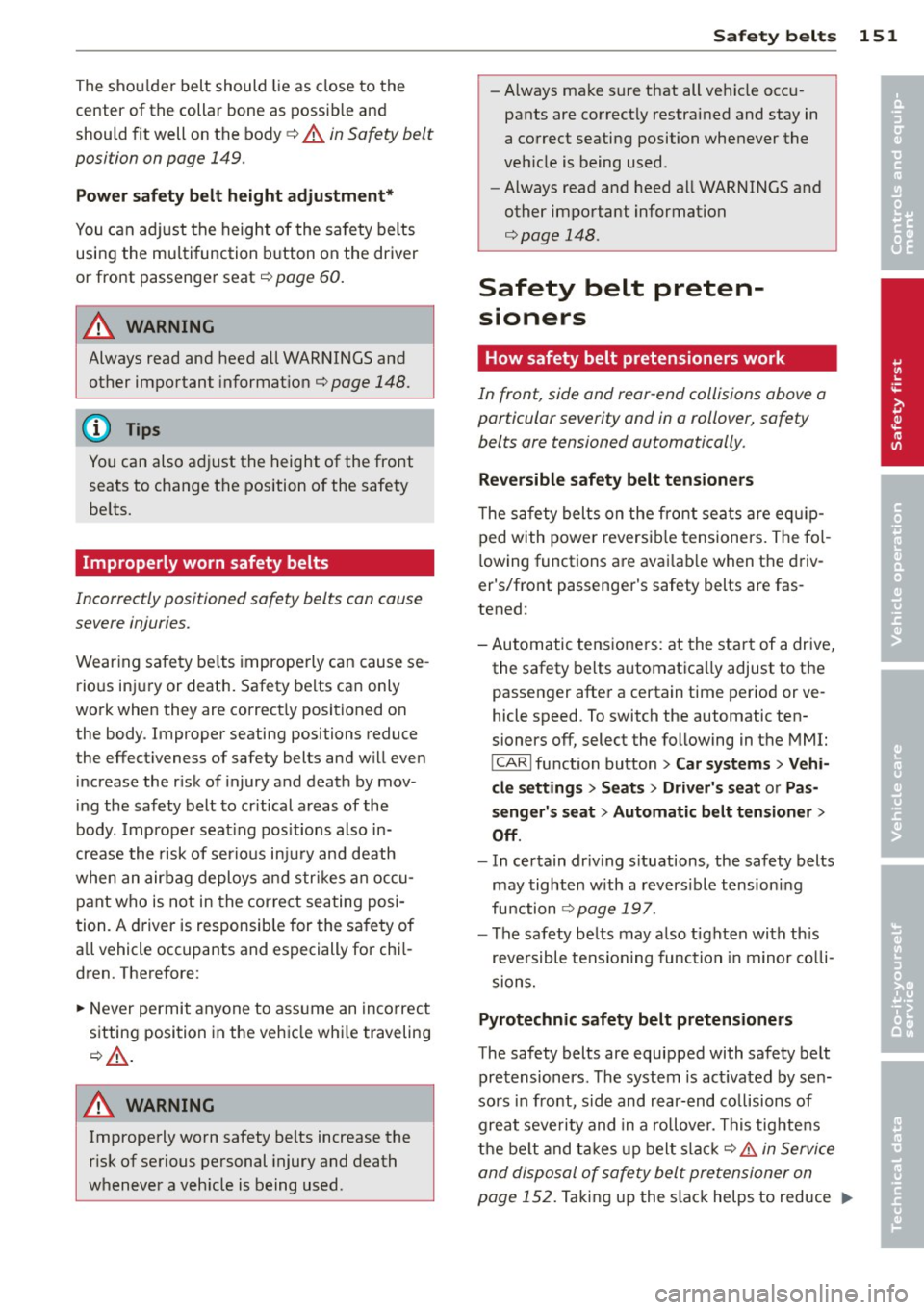
The shoulder belt should lie as close to the
center of the collar bone as possib le an d
should fit well on the body¢
A in Saf ety belt
position on page 149.
Power safety belt h eight adjustment*
You can ad just the height of the safety belts
using the mu lti function b utton on the driver
or fro nt passenge r seat ¢
page 60.
&_ WARNING
-Always read and heed all WARNINGS and
other important informat ion¢
page 148.
You can also a djust the height of the front
seats to change the position of the safety
be lts.
Improperly worn safety belts
Incorrectly positioned safety belts can cause
severe injuries.
Wear ing sa fe ty be lts imprope rly can cause se
rio us in jury or death. Safety be lts can only
wo rk when they are correct ly positioned on
the body. Improper seating positions reduce
the effect iveness of safety belts and w ill eve n
increase the r isk of injury and death by mov
in g the safety belt to cr itical a reas of the
body. Imprope r seat ing pos itions also in
crease the risk of serio us in jury and death
when an air bag deploys and strikes an occu
p a nt who is not in the cor re ct seating posi
tion. A driver is responsib le for the sa fe ty of
all vehicle occupants and especially for chi l
dren . Therefore:
""N ever permit anyone to ass ume an inco rrec t
s itting position in the veh icle w hile traveling
¢.&, .
&_ WARNING
Imprope rly worn safety belts increase the
r isk of se rious personal injury and death
whenever a veh icle is being used .
Safety belts 151
- Always ma ke s ure that all ve hicle occu
pants are co rrectly restrained and stay in
a co rrect seating position whenever the
veh icle is being used .
- Always read and heed all WARNI NGS and
o ther impo rtant inf ormation
¢page 148.
Safety belt preten
sioners
How safety belt pretensioners work
In front, side and rear-end collisions above a
particular severity and in a rollover, safety belts are tensioned automatically.
Reversible safety belt tensioners
T he s afety belts o n the fro nt seats ar e eq uip
ped with powe r reversi ble tensioners. The fo l
l ow ing functions a re ava ila bl e when the driv
er 's/fro nt passenge r's safety belts are fas
tened :
- Au tomatic tens ioners : at the star t of a drive,
the safety be lts automat ica lly adjust to the
passenger afte r a certain time period or ve
hicle speed. To switch the automatic ten
sioners off, select the following in t he M MI:
!CARI fu nction button > Car systems > Vehi
cle settings > Seats > Driver's seat or Pas
senger's seat > Automatic belt tensioner
>
Off .
-In ce rtain dr iv ing s ituations , the safety b elts
may tight en with a reve rs ible tens ion ing
fu nction
¢ page 197.
-The safety be lts m ay a lso tighten with th is
reve rsible te nsion ing functio n in m inor co ll i
s ion s.
Pyrotechnic safety belt pretensioners
The safety belts are equipped with safety be lt
pre tensioners . The system is act ivated by se n
so rs in front, s id e and r ear-end co llisions of
great seve rity and in a rollover. T his tig hte ns
t he be lt and t akes up belt slack ¢.&.
in Service
and disposal of s afe ty belt pretensioner on
page 152.
Tak in g up the s lack helps to reduce .,. •
•
Page 154 of 314
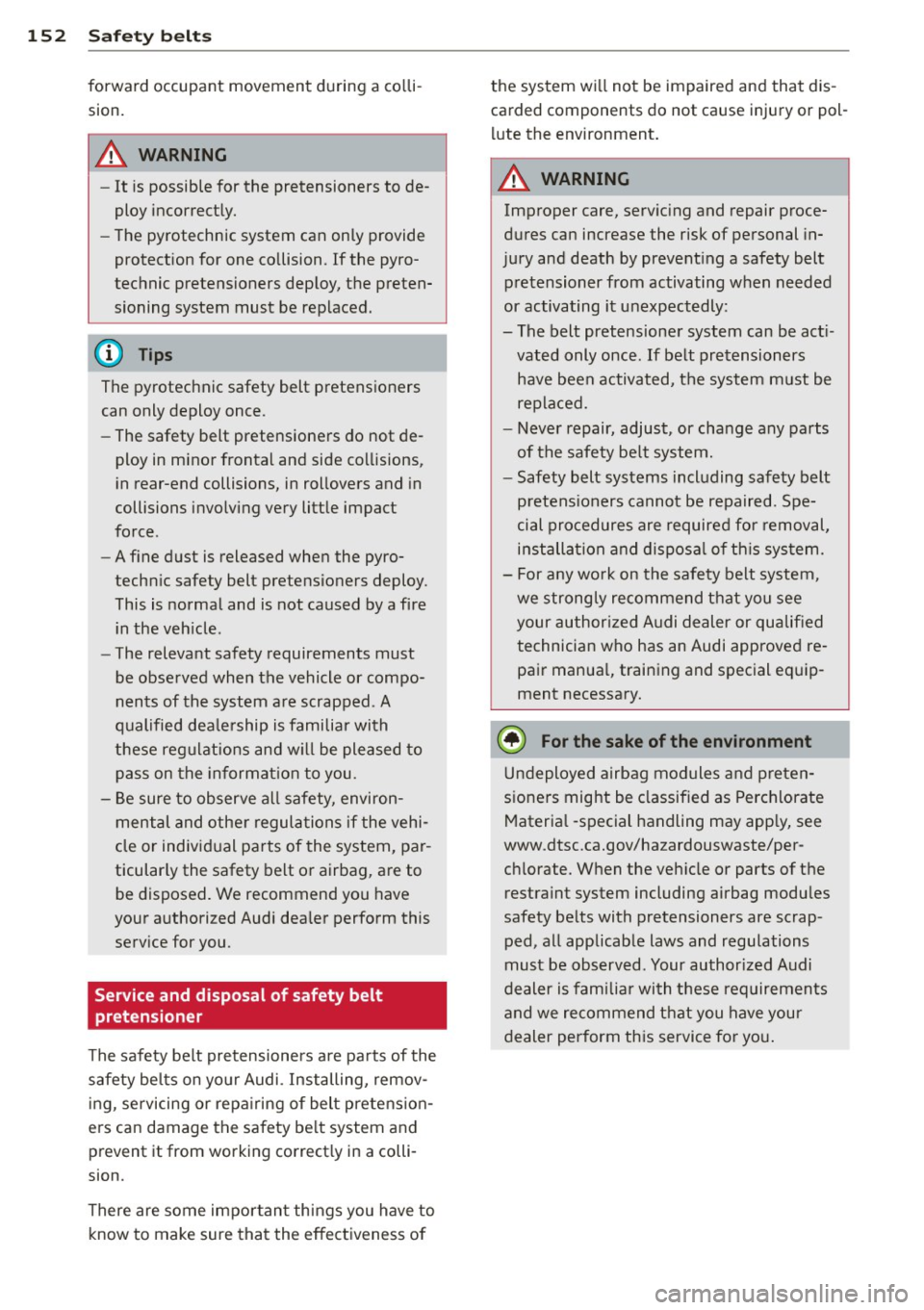
152 Safety belts
forward occupant movement during a co lli
sion.
A WARNING
- It is possible for the pretensioners to de
ploy incorrectly.
- The pyrotechnic system can only provide
protection for one co llision. If the pyro
technic pretensioners deploy, the preten
sioning system must be replaced.
(D Tips
The pyrotechnic safety belt pretensioners
can only deploy once.
- The safety belt pretensioners do not de
ploy in minor frontal and side collisions,
in rear-end collisions, in rollovers and in
collisions invo lving very litt le impact
force .
- A fine dust is released when the pyro
techn ic safety belt pretens ioners deploy.
This is normal and is not caused by a fire i n the veh icle.
- The relevant safety requirements must
be obse rved when the vehicle or compo
nents of the system are scrapped . A
qualified dea le rship is familiar with
these regulations and w ill be pleased to
pass on the informat ion to you.
- Be sure to observe all safety, environ
mental and other regulations if the vehi
cle or indiv id ual parts of the system, par
ticularly the safety belt or airbag, are to
be disposed. We recommend you have
your a uthorized Audi dea ler perform this
serv ice for you .
Service and disposal of safety belt
pretension er
The safety belt pretensione rs are parts of the
safety bel ts on your Audi . Installing, remov
ing, servicing or repa iring of belt pretens ion
e rs can damage the safety be lt system and
prevent it from working correct ly in a colli
sion.
There are some important th ings you have to
know to make sure that the effect iveness of the system wi
ll not be impaired and that dis
carded components do not cause injury or pol
l ute the environment .
A WARNING ,.__
Improper care, servic ing and repair proce
dures can increase the risk of personal in
jury and death by preventing a safety belt
pretensioner from activating when needed
or activating it unexpectedly :
- The belt pretensioner system can be act i
vated only once. If belt pretensioners have been activated, the system must be
replaced.
- Never repair, adjust, or change any parts
of the safety be lt system.
- Safety belt systems including safety belt
pretens ioners cannot be repaired. Spe
cial procedures are required for removal,
installation and disposa l of th is system.
- For any wo rk on the safety belt system,
we strongly recommend that you see
your author ized Audi dealer or qualified
technician who has an Audi approved re
pair manua l, training and special equip
ment necessary.
@) For the sake of the environment
Undeployed airbag modules and preten
sioners might be classified as Perchlorate Materia l -special handling may app ly, see
www .dtsc.ca.gov/hazardouswaste/per
ch lorate. When the veh icle or parts of the
restraint system including airbag modu les
safety belts with pretensioners are scrap ped, all applicable laws and regulations
must be observed . Your author ized Audi
dealer is familia r with these requirements
and we recommend that you have your
dealer perform this service for you .
Page 155 of 314
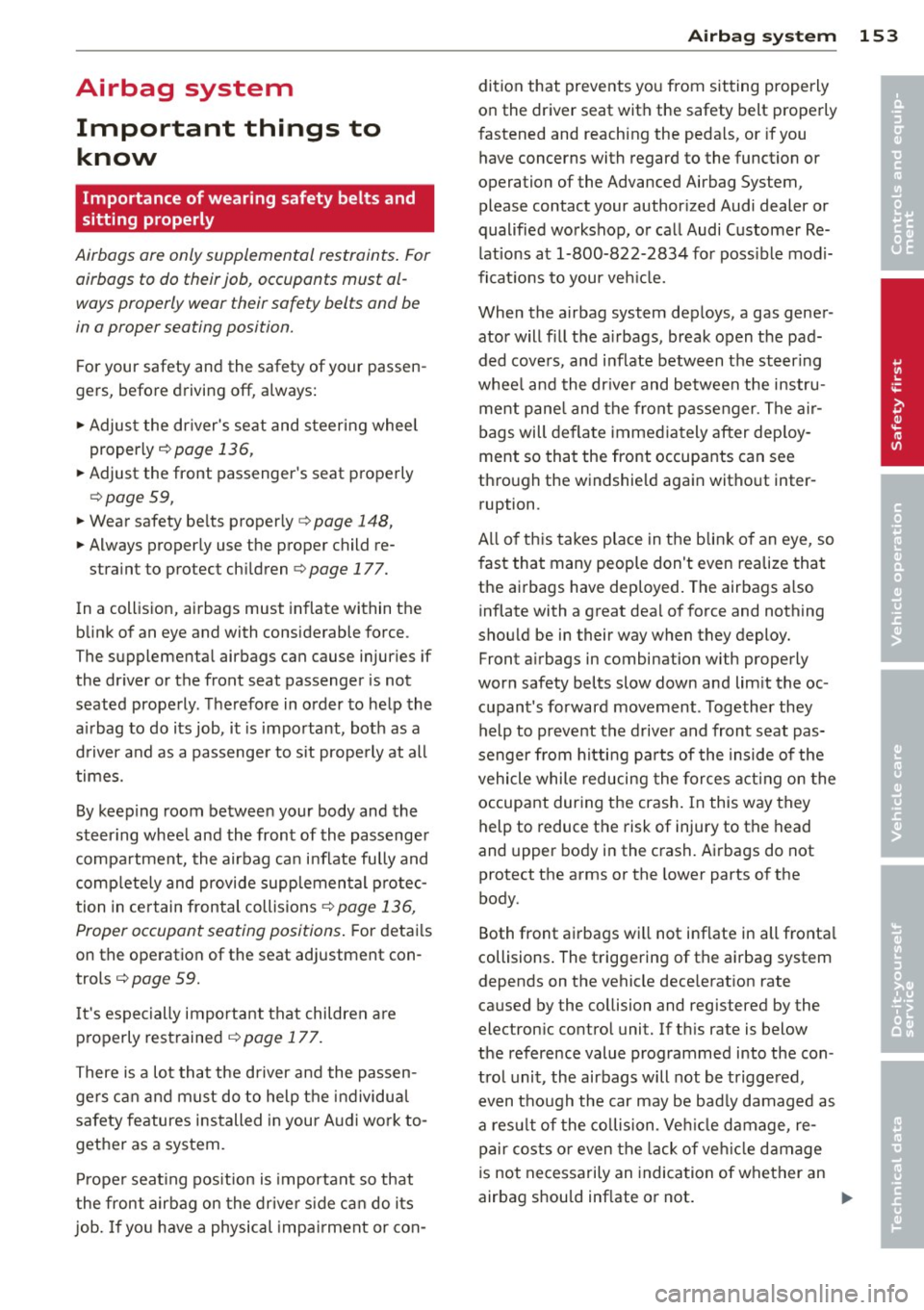
Airbag system Important things to know
Importance of wearing safety belts and
sitting properly
Airbags are only supplemental restraints. For
airbags to do their job , occupants must al
ways properly wear their safety belts and be
in a proper seating position.
For your safety and the safety of your passen
gers, before driving off, always:
"" Adjust the driver's seat and steering wheel
properly ¢
page 136,
"" Adjust the front passenger's seat properly
¢ page 59,
""Wear safety be lts properly ¢ page 148,
""Always properly use the proper child re-
straint to protect chi ldren
r::::> page 177.
In a collision, airbags must inflate within th e
blink of an eye and with considerable force .
The supplemental airbags can cause injuries if
the driver or the front seat passenger is not
seated properly . T herefore in order to help the
a irbag to do its job, it is important, both as a
driver and as a passenge r to s it properly at all
times.
By keeping room between your body and the
steer ing whee l and the front of the passenger
compartment, the airbag can inflate fully and
comp lete ly and provide supp lemental protec
tion in certain frontal collisions
r::::> page 136,
Proper occupant seating positions.
F or detai ls
on the operation of the seat adjustment con
trols ¢
page 59.
It's especially important that children a re
properly restrained
r::::> page 177.
There is a lot that the driver and the passen
gers can and must do to help the individual
safety features installed in your Aud i work to
gether as a system.
Prope r seat ing pos ition is important so that
the front airbag on the driver side ca n do its
job. If you have a physical impa irment or con-
A irbag system 153
dition that prevents you from sitting properly
on the driver seat with the safety belt properly
fastened and reaching the pedals, or if you
have concerns with regard to the function or
operation o f the Advanced Airbag System,
please contact your author ized Audi dealer or
qualified workshop, or call Audi Customer Re
l ations at 1-800-822-2834 for poss ible modi
ficat io ns to your veh icle.
When the airbag system dep loys, a gas gener
ator will fill the a irbags, break open the pad
ded covers, and inflate between the steer ing
whee l and the dr iver and between the instru
ment panel and the front passenger. The a ir
bags will deflate immediately after dep loy
ment so that the front occupants can see
through the windshield again witho ut inter
ruption .
A ll of th is takes place in the blink o f an eye, so
fast that many people don't even realize that
the airbags have deployed. The airbags a lso
inflate with a great dea l of force and nothing
should be in their way when they deploy.
Front a irbags in combinat ion with properly
worn safety belts slow down and lim it the oc
cupant's forward movement . Together they
help to prevent the driver and front seat pas
senger from h itti ng pa rts of the inside of the
vehicle while reducing the forces acting on the
occupant during the crash . In this way they
help to reduce the risk of injury to the head
and upper body in the crash. Airbags do not
protect the arms or the lower parts of the
body.
Both front airbags will not inflate in all fronta l
collisions . The triggering of the airbag system
depends on the vehicle de ce lerat ion rate
caused by the collision and regis te red by the
elec tron ic control unit. If th is rate is below
the reference value programmed into the con
trol unit, the airbags will not be trigge red,
even though the car may be bad ly damaged as
a res ult of the co llision . Ve hicl e damage, re
pair costs or even the lack of ve hicle damage
is not necessarily an indication of whether an
airbag should inflate or not . •
•
Page 156 of 314
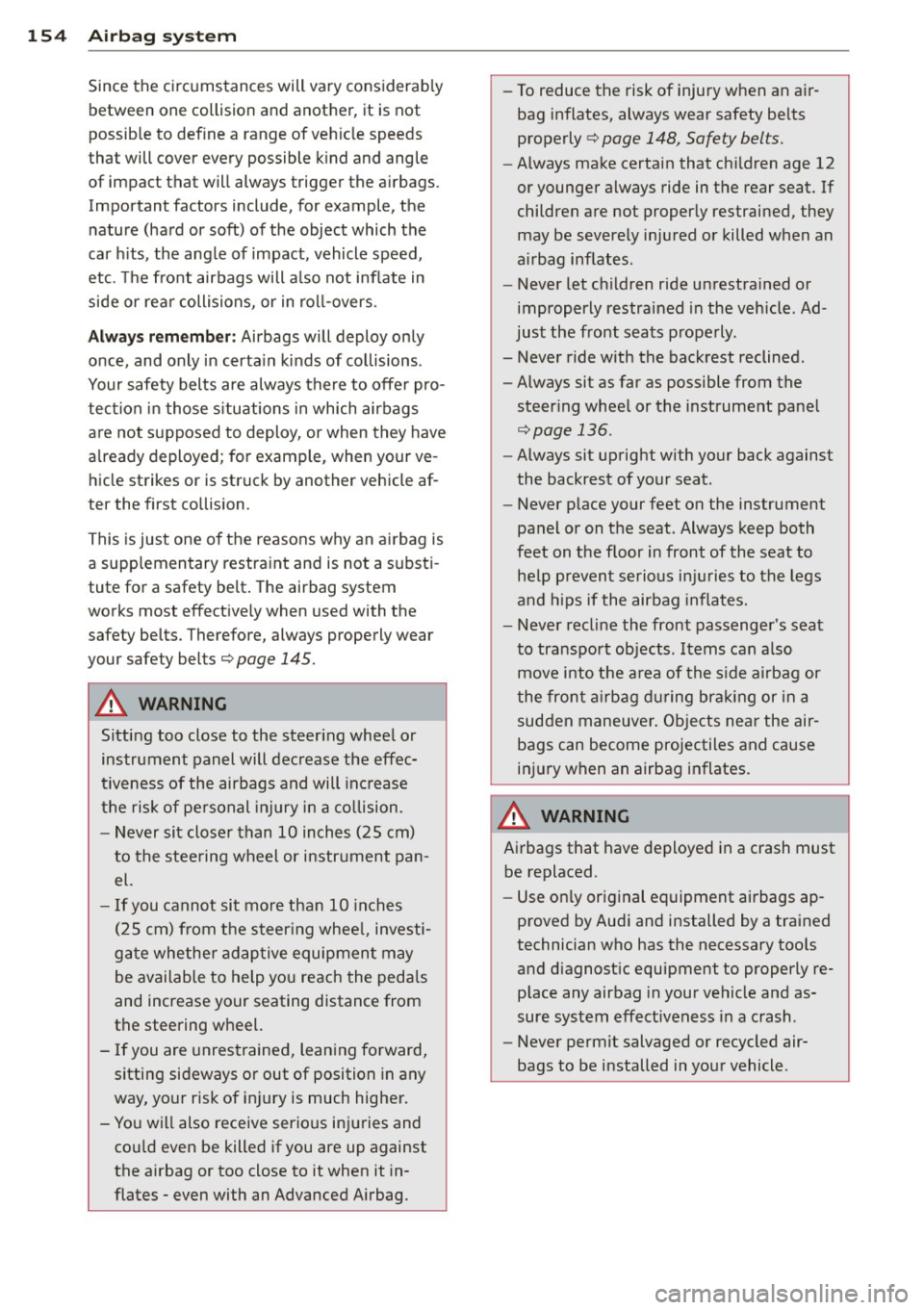
154 Airbag sys te m
Since the cir cumstances will vary considerab ly
between one collision and anot her, it is not
possib le to def ine a range of vehicle speeds
that will cover every possible k ind and angle
of impact t hat will always trigger the airbags.
Important factors include, for example, the
nature (hard or soft) of the object which the
car h its, the ang le of impact, vehicle speed,
etc. The front airbags will also not inflate in
side or rea r collisions, or in ro ll-overs .
Always rememb er: Airbags will deploy only
once, and only in certa in k inds of co llisions.
Your safety belts are always there to offer pro
tection in those s ituations in which airbags
a re not supposed to deploy, or when they have
a lready deployed; for example, when your ve
hicle strikes or is struck by another vehicle af
ter the first co llision.
This is just one of the reasons why an airbag is
a supplementary restraint and is not a substi
tute for a safety belt . The airbag system
works most effect ively when used with the
safety belts. Therefore, always properly wear
your safety belts¢
page 145.
A WARNING
Sitting too close to the steer ing wheel or
instrument panel will dec rease the effec
t iveness of the airbags and will increase
the risk of personal injury in a collision .
- Never sit closer than 10 inches (2S cm)
to the stee ring wheel or instrument pan
el.
- If you cannot sit more than 10 inches
( 2 5 cm) from the s teer ing whee l, investi
gate whethe r adaptive equipmen t may
be available to help you reach the pedals
and increase your seating distance from
the steering wheel.
- If you are unrestrained, lean ing fo rward,
sitting sideways or out of position in any
way, your risk of in jury is much higher.
- You will also receive serio us injuries and
cou ld even be killed if you are up against
the airbag or too close to it when it in
flates - even with an Advanced Airbag. -
To reduce the risk of injury when an a ir
bag inflates, always wear safety be lts
properly ¢
page 148, Safety belts.
-Always make certain that ch ildren age 12
or younger always ride in the rear seat. If
children are not properly restrained, they
may be severely injured or killed when an
airbag inflates.
- Never let children ride unrestrained or
improperly restrained in the vehicle. Ad
just the front seats prope rly .
- Never ride with the back rest reclined.
- Always sit as far as possible from the
steer ing whee l or the instrument pane l
¢page 136.
-Always sit upright with your back against
the backrest of your seat .
- Never p lace your feet on the instrument
panel or on the seat. Always keep both
feet on the floor in front of the seat to
help prevent serio us in ju ries to the legs
and h ips if the airbag inflates.
- Never recline the front passenger 's seat
to transport objects , Items can a lso
move into the a rea of the s ide airbag or
the front a irbag du ring bra king or in a
sudden maneuve r. Objects nea r the air
bags can become projectiles and cause
in jur y when an airbag inflates.
A WARNING ~
Airbags that have deployed in a crash must
be replaced.
- Use on ly orig inal equipment airbags ap
proved by Aud i and installed by a trained
technician who has the necessary too ls
and d iagnost ic equipment to properly re
p lace any airbag in your vehicle and as
sure system effectiveness in a crash .
- Never permit salvaged or recycled air
bags to be installed in your vehicle.
Page 157 of 314
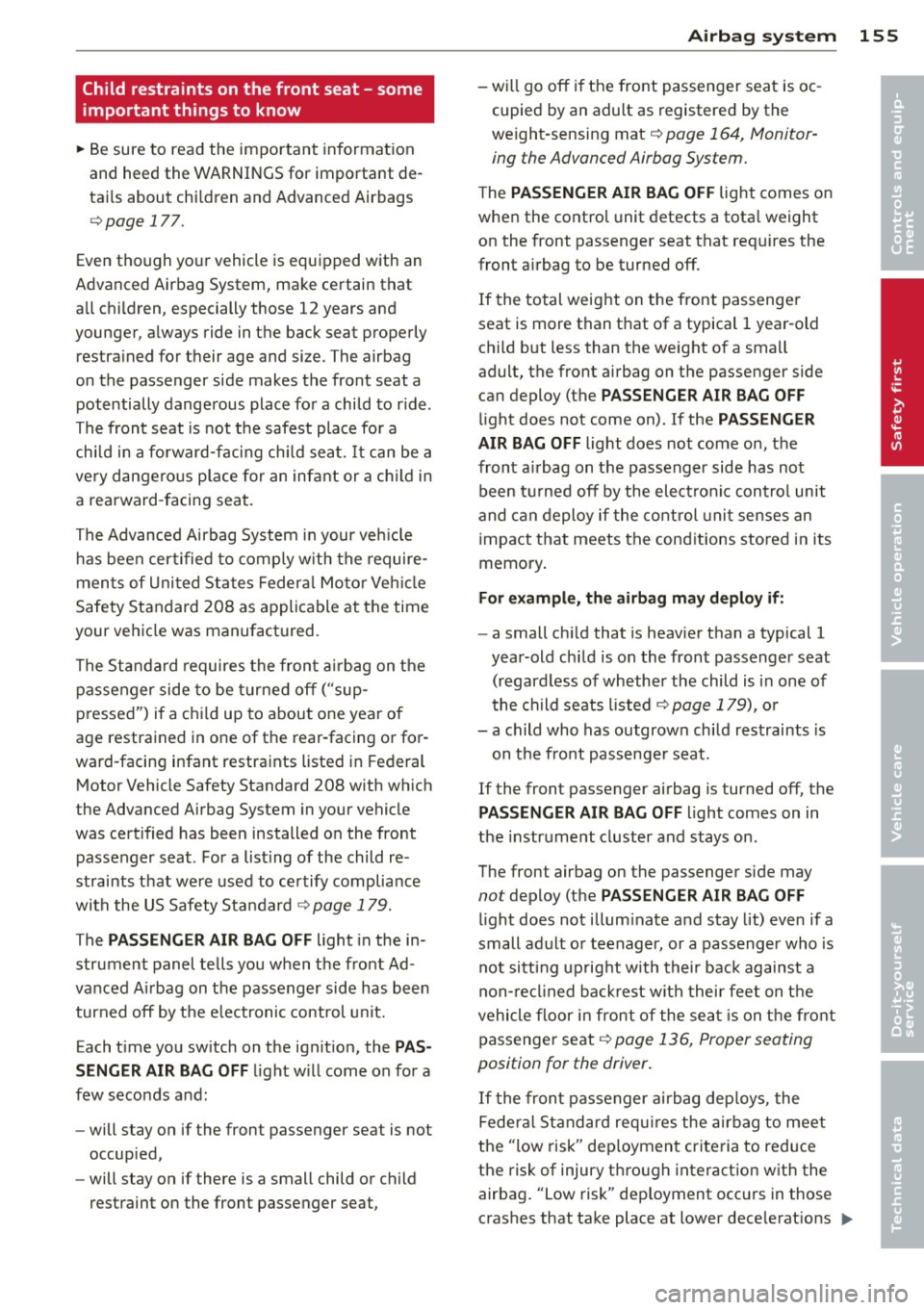
Child restraints on the front seat - some
important things to know
.. Be sure to read the important informat ion
and heed the WARNINGS for important de
tails about chi ldren and Advanced Airbags
~ page 177.
Even though your vehicle is equipped with an
Advanced Airbag System, make certain that
a ll chi ldren, especially those 12 years and
younger, always ride in the back seat properly restrained for their age and si ze. The airbag
on the passenger side makes the front seat a potentially dangerous place for a child to r ide .
The front seat is not the safest place fo r a
chi ld in a fo rward-facing chi ld seat. It can be a
very dange ro us p lace for an infant or a ch ild in
a rearward -facing seat.
The Advanced Airbag System i n your veh icle
has been cert ified to comp ly with the require
men ts of United States Federa l Mo tor Veh icle
Safety Standard 208 as applicable at the time
your vehicle was manufactured.
The Standard requires the front a irbag on the
passenger side to be t urned off ("sup
p ressed") if a child up to about one year of
age restrained in one of the rear -facing or for
ward -facing infant restraints listed i n Federal
Motor Vehicle Safety Standard 208 with wh ich
the Advanced Airbag System in your vehicle
was certified has been installed o n the front
passenger seat . For a listing of the child re
straints that were used to certify compliance
with the US Safety Standard ~
page 179.
The PASS ENG ER AIR BAG OFF light in the in
strument panel tells you when the front Ad
vanced A irbag on the passenger side has been
turned off by the e lectronic control u nit.
Each t ime you sw itch on the ignit ion, the
PAS
SENGER AIR BAG OFF
light w ill come on for a
few seconds and:
- will stay on if the front passenger seat is not
occupied ,
- will stay on if there is a small child or child
restraint on the front passenger seat,
A irbag sys tem 155
- wi ll go off if the front passenger seat is oc
cupied by an adult as registered by the
weight -sensing mat ¢
page 164, Monitor
ing the Advanced Airbag System.
T he PAS SENGER AIR BAG OFF light comes on
whe n the contro l unit detects a tota l weight
on the front passenger seat that req uires the
front a irbag to be turned off.
If the total weight on the front passenger
seat is more than that of a typical 1 year-old
c h ild but less than the weight of a small
adult, the front airbag on the passenger side
can deploy (the
PASSENGER AIR BAG OFF
li ght does not come on). If the PASSENG ER
AIR BAG OFF
light does not come on, the
front a irbag on the passenger side has not
been t urned off by the elect ronic cont ro l unit
and can deploy if the control unit senses an
impact that meets the cond itions stored in its
memory .
For exampl e, th e airb ag may deplo y if:
- a small ch ild that is heav ie r than a typical 1
year-old ch ild is on the front passenger seat
(regard less of whether the child is in one of
the child seats l isted ¢
page 179), or
- a child who has outgrown child restraints is
on the front passenger seat.
If the front passenger airbag is turned off, the
PASSENGER AIR BAG OFF light comes on in
the instr ument cluster and stays on .
The front airbag on the passenger side may
not deploy (the PASSENGER AIR B AG OFF
light does not illum inate and stay lit) even if a
small ad ult or teenager, or a passenger who is
not sitti ng uprig ht w ith their back against a
non -recli ned back rest w it h thei r feet on the
vehicle floor in front of the sea t is on t he front
passenger seat~
page 136, Proper seating
position for the driver.
If the fron t passenger ai rbag dep loy s, the
Federa l Standard req uires the airbag to meet
the "low risk" dep loyment criteria to reduce
the risk of injury t hrough interact ion w ith the
airbag. "Low risk" dep loyment occ urs in those
crashes that take place at lower dece lerat ions .,.. •
•
Page 158 of 314
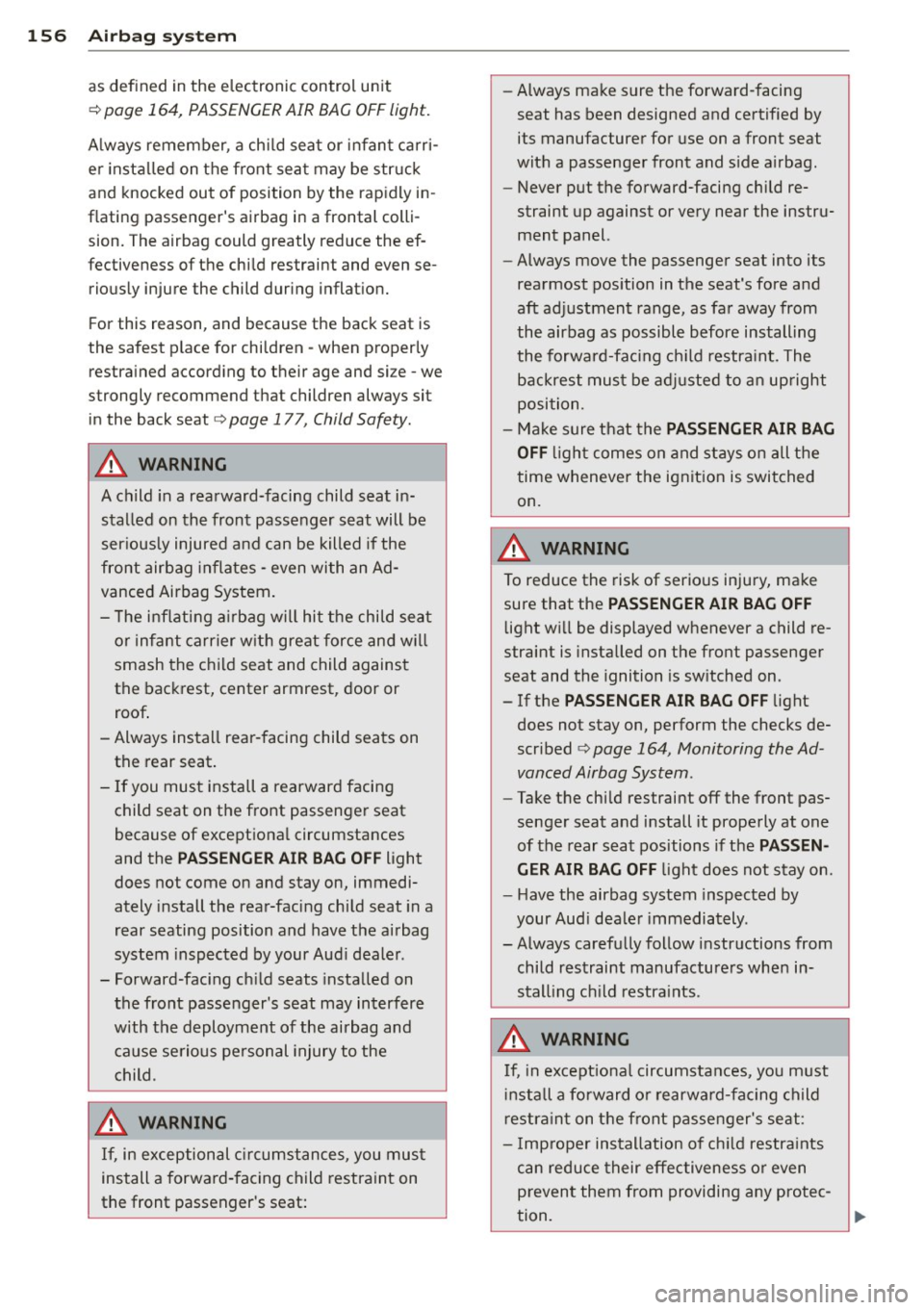
156 Airbag sys te m
as def ined in the electronic control unit
Q page 164, PASSENGER AIR BAG OFF light.
A lways remember, a chi ld seat or infant carr i
e r i nsta lled on the front seat may be struck
and knocked out of position by the rapidly in
flating passenger's airbag in a frontal colli
sion. The airbag could greatly reduce the ef
fectiveness of the chi ld restraint and even se
riously injure the child during inflat ion.
F or this reason, and because the back seat is
the safest p lace for chi ldren -when properly
restra ined accord ing to their age and si ze -we
strongly recommend that children always sit
in the back seat
Q page 177, Child Safety .
A WARNING
A child in a rearward-facing child seat in
stalled on the front passenger seat will be
ser iously injured and can be killed if the
front airbag inflates -even with an Ad
vanced Airbag System.
- The inflating a irbag will hit the child seat
or infant carrier w ith great force and w ill
smash the ch ild seat and child against
the backrest, center armrest, door or
roof .
- Always install rear -facing child seats on
the rear seat .
- If you must install a rearward facing
child seat on the f ront passenge r seat
because of except iona l circumstances
and the
PASSENGER AIR BAG OFF light
does not come on and stay on, immedi
ately i nstall the rear-facing chi ld seat in a
rear seating position and have the airbag
system inspected by your Aud i dealer .
- Forward-fac ing ch ild seats installed on
the front passenger's seat may interfere
with the deployment of the airbag and c ause se rious pe rsonal injury to the
c hild.
A WARNING
If, in exceptional c ircumstances, you mus t
install a forwa rd-facing child restra int on
the front passenger's seat: -
Always make sure the forward-facing
seat has been designed and certified by
its manufacturer for use on a front seat
with a passenger front and s ide a irbag .
- Never put the forward-facing child re
straint up against or very near the instru ment panel.
- Always move the passenger seat into its
rearmost pos ition in the seat's fore a nd
aft adjustment range, as fa r away from
the airbag as possible before installing
the forwa rd-fa cing ch ild restra int. The
b ackrest mus t be ad justed to an up right
position.
- Make sure that the
PASSENGER AIR BAG
OFF
li ght comes on and stays o n all the
time wheneve r the ignition is switched
on.
A WARNING -ra----
To reduce the risk of serious injury, make
sure that the
PASSENGER AIR BAG OFF
light will be displayed whenever a child re
straint is installed on the front passenger
seat and the ignition is sw itched on.
- If the
PASSENGER AIR BAG OFF light
does not stay on, perform the checks de
scribed
Q page 164, Monitoring the Ad
vanced Airbag System .
-Take t he chi ld restraint off the front pas
senger seat and install it properly at one
of the rear seat positions if the
PASSEN
GER AIR BAG OFF
light does not stay on.
- Have the airbag system inspected by
your Aud i dea le r i mmediately .
- Always carefully follow instr uctions from
child restraint manufacture rs when in
stall ing c hild restra ints .
A WARNING
If, in except iona l circumstances, you m ust
i nstall a forward o r rearwa rd-fa cing child
r estra int on the front p assenger's se at:
- I mp roper installation of ch ild restra ints
c a n reduce their effectiveness or even
p revent them from providing any protec -
tion. .,..
Page 159 of 314
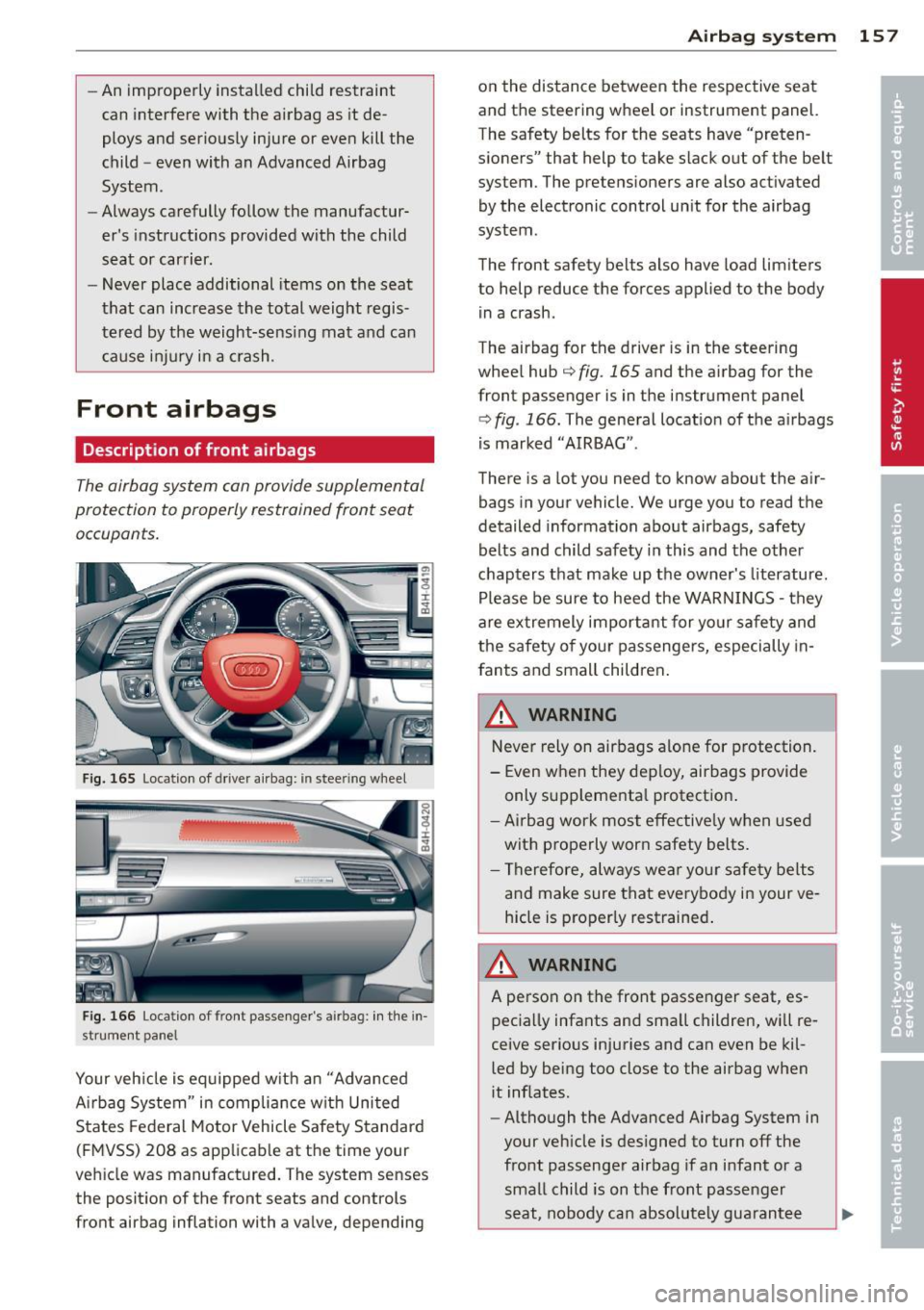
-An improperly installed child restraint
can interfere with the airbag as it de
ploys and seriously injure or even kill the
child -even with an Advanced Airbag
System .
- Always carefully follow the manufactur
er's instructions provided with the child
seat or carrier .
- Never place additional items on the seat
that can increase the total weight regis
tered by the weight-sensing mat and can cause injury in a crash.
Front airbags
Description of front airbags
The airbag system can provide supplemental
protection to properly restrained front seat occupants.
Fig. 165 Location of dr iver a irbag: i n stee ring wheel
Fig. 166 Location of front passenger's a irbag: in the in
strument panel
Your vehicle is equipped with an "Advanced
Airbag System" in compliance with United
States Federal Motor Vehicle Safety Standard
(FMVSS) 208 as applicable at the time your
vehicle was manufactured. The system senses
the position of the front seats and controls front airbag inflation with a valve, depending
Airbag system 157
on the distance between the respective seat
and the steering wheel or instrument panel.
The safety belts for the seats have "preten
sioners" that help to take slack out of the belt
system. The pretensioners are also activated
by the electronic control unit for the airbag
system.
The front safety belts also have load limiters
to help reduce the forces applied to the body in a crash .
The airbag for the driver is in the steering
wheel hub¢
fig. 165 and the airbag for the
front passenger is in the instrument panel ¢
fig . 166. The general location of the airbags
is marked "AIRBAG" .
There is a lot you need to know about the air
bags in your vehicle. We urge you to read the
detailed information about airbags, safety
belts and child safety in this and the other
chapters that make up the owner's literature.
Please be sure to heed the WARNINGS -they
are extremely important for your safety and
the safety of your passengers, especially in
fants and small children.
Never rely on airbags alone for protection.
- Even when they deploy, airbags provide only supplemental protect ion .
- Airbag work most effective ly when used
with properly worn safety belts.
- Therefore, always wear your safety belts
and make sure that eve rybody in your ve
hicle is properly restrained .
&_ WARNING
A person on the front passenger seat, es
pec ially infants and sma ll children, will re
ceive serious injuries and can even be kil
led by being too close to the airbag when
it inflates .
- Although the Advanced Airbag System in
your vehicle is designed to turn off the
front passenger airbag if an infant or a
small child is on the front passenger
seat, nobody can absolutely guarantee
11-
Page 160 of 314
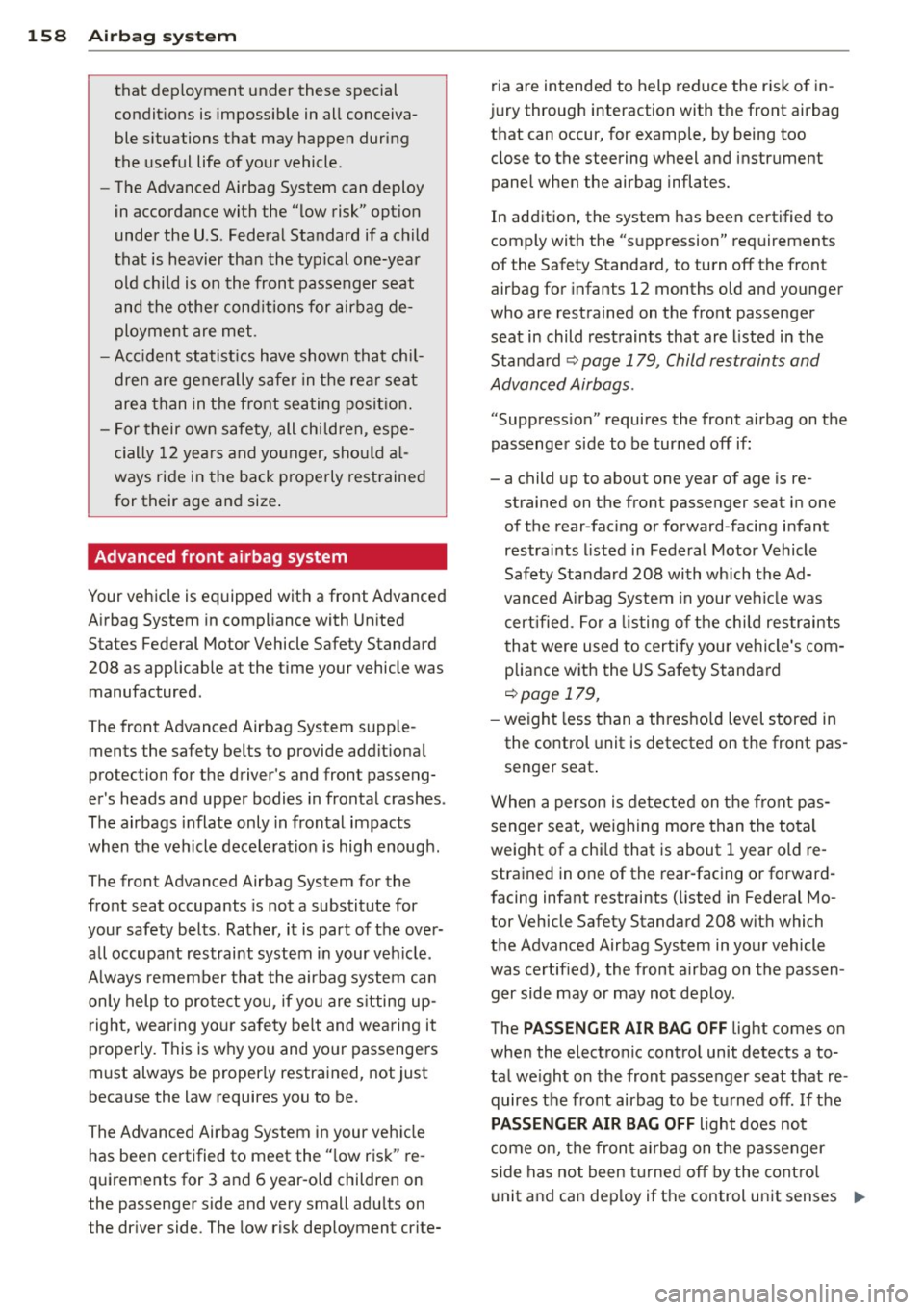
158 Airbag system
that deployment under these special
conditions is impossible in all conceiva
ble situations that may happen during
the useful life of your vehicle .
- The Advanced Airbag System can deploy
in accordance with the "low risk" option
under the U.S . Federal Standard if a child
that is heavier than the typical one-year old child is on the front passenger seat
and the other conditions for airbag de
ployment are met .
- Accident statistics have shown that chil
dren are generally safer in the rear seat
area than in the front seating position.
- For their own safety, all children, espe
cially 12 years and younger, should al
ways ride in the back properly restrained
for their age and size.
Advanced front airbag system
Your vehicle is equipped with a front Advanced
Airbag System in compliance with United
States Federal Motor Vehicle Safety Standard
208 as applicable at the time your vehicle was manufactured .
The front Advanced Airbag System supple ments the safety belts to provide additional
protection for the driver's and front passeng
er's heads and upper bodies in frontal crashes .
The airbags inflate only in frontal impacts
when the vehicle deceleration is high enough.
The front Advanced Airbag System for the
front seat occupants is not a substitute for
your safety belts . Rather, it is part of the over
all occupant restraint system in your vehicle .
Always remember that the airbag system can
only help to protect you , if you are sitting up
right, wearing your safety belt and wearing it
properly. This is why you and your passengers
must always be properly restrained, not just
because the law requires you to be.
The Advanced Airbag System in your vehicle has been certified to meet the "low risk" re
quirements for 3 and 6 year-old children on
the passenger side and very small adults on
the driver side. The low risk deployment crite- ria
are intended to help reduce the risk of in
jury through interaction with the front airbag that can occur, for example, by being too
close to the steering wheel and instrument
panel when the airbag inflates.
In addition, the system has been certified to
comply with the "suppression" requirements
of the Safety Standard, to turn off the front
airbag for infants 12 months old and younger
who are restrained on the front passenger
seat in child restraints that are listed in the
Standard
¢ page 179, Child restraints and
Advanced Airbags .
"Suppression" requires the front airbag on the
passenger side to be turned off if:
- a child up to about one year of age is re strained on the front passenger seat in one
of the rear -facing or forward-facing infant
restraints listed in Federal Motor Vehicle
Safety Standard 208 with which the Ad
vanced Airbag System in your vehicle was
certified . For a listing of the child restraints
that were used to certify your vehicle's com
pliance with the US Safety Standard
¢page 179,
-weight less than a threshold level stored in
the control unit is detected on the front pas
senger seat.
When a person is detected on the front pas senger seat, weighing more than the total
weight of a child that is about 1 year old re
strained in one of the rear-facing or forward
facing infant restraints (listed in Federal Mo
tor Vehicle Safety Standard 208 with which
the Advanced Airbag System in your vehicle
was certified), the front airbag on the passen
ger side may or may not deploy.
The
PASSENGER AIR BAG OFF light comes on
when the electronic control unit detects a to
tal weight on the front passenger seat that re
quires the front airbag to be turned off. If the
PASSENGER AIR BAG OFF light does not
come on, the front airbag on the passenger
side has not been turned off by the control
unit and can deploy if the control unit senses ..,_